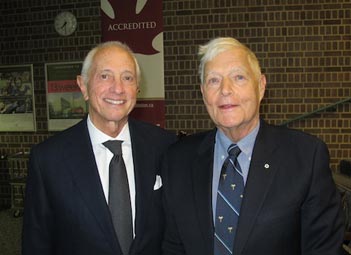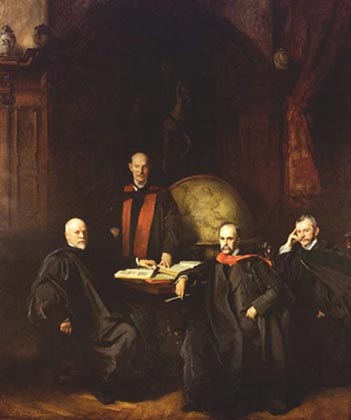The Bizarre Double Life of Dr. Halsted

from left to right: Kergin Lecturer Gerald Imber with historian Michael Bliss
|
The Kergin Lecture celebrates the memory of
Frederick Gordon Kergin, a Rhodes scholar,
and Chairman of the Department of Surgery
from 1957-1966, who served as Dean of the
Medical School, integrated all of the residencies
at the University of Toronto, was President of the
American Association for Thoracic Surgery and
left us a legacy of excellence in surgical education.
|
Dr. Gerald Imber began his Kergin Lecture with a riveting
clinical case –an operation for gall stones in April of
1882 on a 70 year old febrile jaundiced patient in extremis.
The description concluded with a sentence characteristic
of Imber’s writing style. “The patient recovered
uneventfully and was symptom free for the remaining
two years of her life. William Stewart Halsted had successfully
performed the first known operation to remove
gall stones and in the process had brought his mother
back from the brink of death.”
Imber described Halsted as an innovator in surgery
and surgical education. He invented local anesthesia for
surgical treatment, successful repair of inguinal hernia,
radical mastectomy, and surgical training as we currently
know it. He was a pioneer of sterile technique. All of
these contributions were made during 33 years of addiction
to cocaine and morphine.
The story Imber told(1) at University Rounds began
with a picture of New York City in 1852, the year of
Halsted’s birth. “The city was not pretty. Manure and
sewage in the streets. Tuberculosis rampant. 50% of children
died before the age of 5. The Halsted family moved
uptown to 14th Street, where they lived next to Thomas
Edison, who lit his house 24 hours a day to advertise
his invention of the incandescent bulb. Halsted was initially
home – schooled, then entered boarding school at
Andover, Massachusetts from which he escaped and was
recaptured twice. At Yale, where he walked with a George
W. Bush swagger, he played shortstop on the baseball
team and was captain of the football team. He graduated
near the bottom of his class, having never borrowed
a book from Yale Library. In his 4th year, he discovered
Gray’s Anatomy and Dalton’s Physiology text, which he
memorized, and then decided on a career in medicine.
He entered the Physicians and Surgeons Medical School
at Columbia, a few blocks from his home. There were
no laboratories, poor lectures and jeering students. The
best educational pathway was via the ‘quizzes’, given by
individual practitioners on a private tuition bases.
“Halsted bought extra cadavers, and became expert
enough in anatomy to teach his fellow students. He served
as an assistant to Dalton who was his laboratory mentor,
and then interned at Bellevue hospital, the first choice of
the best students in the city. During those years 50 operations
were performed per year, mostly for treatment of fractures
and drainage of abscesses. Surgeons wore dirty operating
coats and there were no efforts at aseptic technique.
Frank Hamilton, the surgeon-hero of the Battle of Bull
Run, rode to New York Hospital on his white horse and
went directly to the operating room to perform surgery.
“Halsted finished in the top 10% of his class, then
took a job at the New York Hospital on 16th Street.
There he developed many innovations including charting
the pulse, temperature and respiratory rate of
patients. He completed a 2-year tour in Europe, where
he worked with Billroth, Esmark, and other surgical
leaders. In 1880, he returned to New York, where he
joined the staff of six hospitals including Roosevelt,
New York Hospital, Bellevue and others. He became
an extremely busy surgeon, invented aeration of the
blood as a treatment for carbon-monoxide poisoning,
a common problem in those days, related to the engine
exhaust of ferry boats in the New York area. He may have
transfused his own blood into his sister for treatment of
puerperal hemorrhage.
“In 1884, the distinguished Viennese neurologist
Sigmund Freud described the use of cocaine as a local
anesthetic. Freud used it in the eye for trachoma.
Halsted tried cocaine, injecting at many sites to see the
blocking effect on various nerves, using his own body
for the experiments, and administered it to his quiz
groups, many of whom became addicted and some of
whom died. He performed 1,000 operations under local
cocaine. When he became addicted, his friend and colleague
William Welch, later Dean at Johns Hopkins,
took him on a sailing trip to the Windward Islands,
titrating his cocaine use in an attempt to wean him from
the drug. Halsted broke into the locker, stole the cocaine,
returned to New York and was subsequently sent to the
Butler Hospital in Providence for treatment. He spent 7
months at that institution where his cocaine addiction
was ‘cured’ by the substitution of morphine addiction.
“Welch eventually invited Halsted to Hopkins where
he studied anatomy with Franklin Mall. They described
the arcades of the mesentery and Halsted invented
a technique to make intestinal anastomosis safe, by
emphasizing the strength of the submucosa. He lectured
at various medical schools. On the way to Harvard, he
stopped at the Butler Hospital in Providence, to once
again be cured of cocaine addiction. Halsted and Welch
were subsequently joined at Hopkins by William Osler
and Howard Kelly, a gifted gynecologic surgeon. These
four leaders were portrayed by John Singer Sargent.
|
“The surgeons began to follow the precepts of Joseph
Lister. Halsted emphasized clean nails, clean clothes,
and well laundered white duck uniforms. Eventually, he
ordered rubber gloves from the Goodyear Tire and Rubber
company for his scrub nurse and future wife, Carolyn
Hampton, who had developed dermatitis from the antiseptic
use of carbolic acid. In 1889, Halsted developed an
anatomical operation for inguinal hernia, which until that
time had been uniformly resistant to repair. He published
12 cases with no recurrence. Bassini, unknown to Halsted,
had developed a similar operation and Halsted always
gave credit to Bassini for his contribution. Halsted next
worked on breast tumours, which had a 50% local recurrence
rate. Halsted devised the radical mastectomy, lowering
the local recurrence rate to 6%. He was a meticulous
surgeon, slow by the standards of the day, which expected
‘slash and dash’ operations derived from the military surgeons
of the civil war like Frank Hamilton. During the
war, surgeons kept the sutures in their mouths, so that
they were immediately available for mass ligation. Halsted
devised the Halsted hemostat, gentle handling of tissues
and changed surgery for ever.

The Four Doctors by John Singer Sargent, 1906. From left, Welch, Halsted
(standing), Osler, and Kelly
“Halsted decided to train resident surgeons and hire
surgical professors as full- time employees of the medical
school. He progressively drifted from his extremely busy
surgical schedule, tending to drop out during cases only
to return reinvigorated later in the day. He once admitted
to Osler that he was taking 195 mg of morphine per
day. He was able to titrate himself with the 4 PM break,
so that he came back refreshed.
“Halsted developed surgical specialties through his
trainees. Hugh Young was designated to develop urology
and Harvey Cushing, who brought an X-ray machine
with him from Massachusetts General Hospital when
he was hired in 1896, was encouraged to develop neurosurgery.
Cushing remained with Halsted for 14 years as
resident and assistant.
“Johns Hopkins developed its medical school to a 4
year program, with a dog surgery laboratory rotation
in the 3rd year. Halsted rarely showed up for these
exercises. Cushing taught them meticulously, requiring
that dogs be treated the same as human patients, with
charts, sterile technique and vigilant follow-up care.
Cushing introduced the repair of inguinal hernia under
local cocaine anesthesia. Halsted was not allowed to use
cocaine in patients because of his prior addiction. He
drifted in and out of the clinics, asked about scheduling
patients already two weeks post-op. Cushing fathered
neurosurgery, eventually leaving Hopkins for the Peter
Bent Brigham Hospital. Hoyer, one of Halsted’s trainees,
developed chest surgery for the Hopkins Hospital.
He became a noted chest surgeon after leaving Hopkins
for Cincinnati, and then Cornell, where he was chief of
surgery for twenty years.” Halsted spent 2 months each
year, living with his wife in Hampton, then travelling
for 4 months in Europe, visiting various surgeons. It is
suspected that he used cocaine during these sojourns and
then came back to work on morphine. At 70, Halsted
developed acute cholecystitis and common duct stones,
followed by gastrointestinal hemorrhage. He died following
surgery by his residents.”
Imber’s excellent biography “Genius on the Edge: The
Bizarre Double Life of Dr. William Steward Halsted”
was distributed by our Department to the overflow audience
attending Imber’s Kergin lecture. It is a fascinating
story, brilliantly told.
M.M.
1. I have reported the lecture here from my notes. Quotation
marks are used to convey a sense of participation to the
reader. They should not be taken as evidence of an accurate
record of what was said.
|
Dr. GERALD IMBER is a well – known plastic
surgeon and authority on cosmetic surgery, and
directs a private clinic in Manhattan. He is
assistant clinical professor of surgery at Weill-
Cornell School of Medicine, and staff at the New
York – Presbyterian Hospital, where he served his
residency, and learned a great deal of Dr. Halsted.
© from the publisher’s note in Genius on the Edge: The
Bizarre Double Life of Dr. William Stewart Halsted
|
|